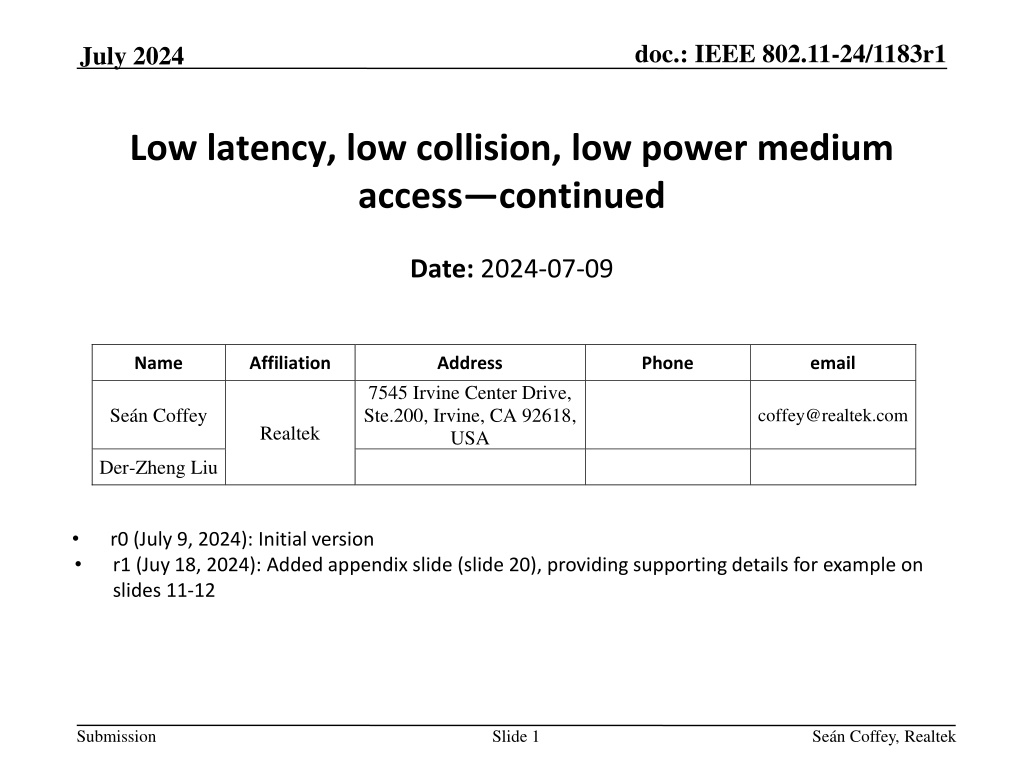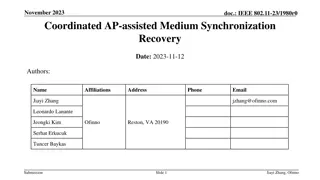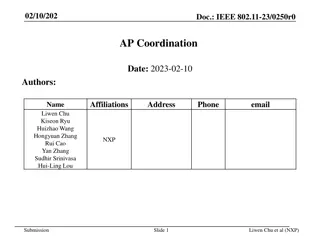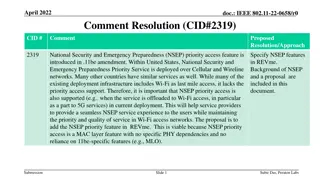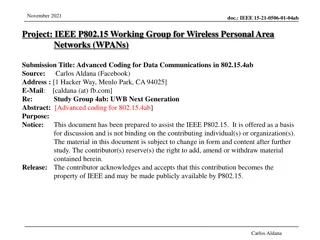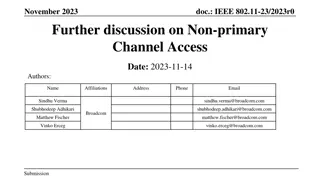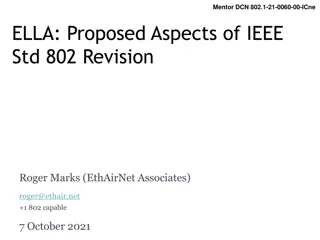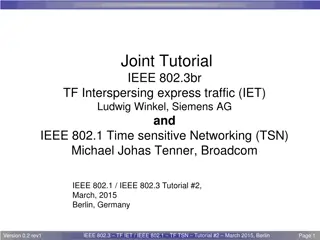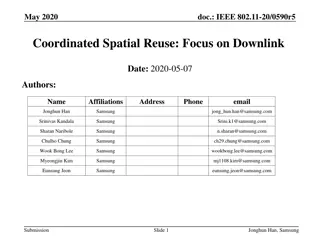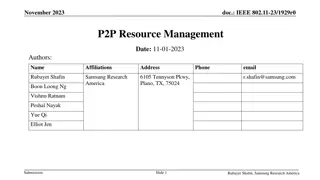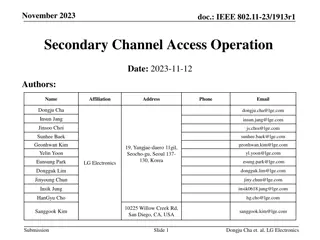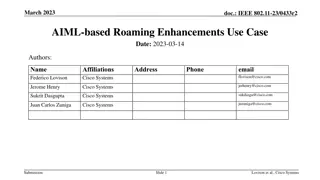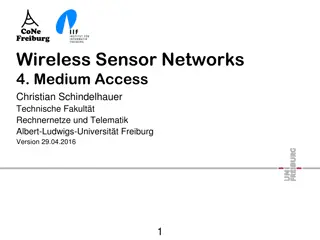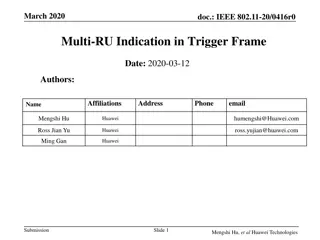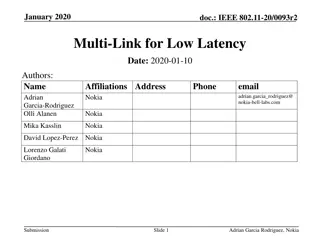Enhancing Medium Access Efficiency in IEEE 802.11 Networks
This presentation discusses the utilization of chirp signals for Ultra High Rate (UHR) STAs to access the medium efficiently, transmit reliably at reduced power levels, and handle interference challenges in IEEE 802.11 networks. It explores the concept of chirps, their differentiation from other proposals, and their potential impact on future network performance, device identification, and traffic assessment across Basic Service Sets (BSSs). The review addresses issues related to uplink medium access without pre-scheduled agreements, contention resolution, interference management, and connectivity challenges faced by STAs.
Download Presentation

Please find below an Image/Link to download the presentation.
The content on the website is provided AS IS for your information and personal use only. It may not be sold, licensed, or shared on other websites without obtaining consent from the author. Download presentation by click this link. If you encounter any issues during the download, it is possible that the publisher has removed the file from their server.
E N D
Presentation Transcript
doc.: IEEE 802.11-24/1183r1 July 2024 Low latency, low collision, low power medium access continued Date: 2024-07-09 Name Affiliation Address Phone email 7545 Irvine Center Drive, Ste.200, Irvine, CA 92618, USA Se n Coffey coffey@realtek.com Realtek Der-Zheng Liu r0 (July 9, 2024): Initial version r1 (Juy 18, 2024): Added appendix slide (slide 20), providing supporting details for example on slides 11-12 Submission Slide 1 Se n Coffey, Realtek
doc.: IEEE 802.11-24/1183r1 July 2024 Abstract A previous presentation [1] introduced the chirp as a method for UHR STAs: to access the medium efficiently (quickly, and without collisions), outside the scope of pre-scheduled agreements, and to complete transmissions reliably (low or no loss due to interferers), even at greatly reduced transmit power levels. This follow-up presentation adds the following: What the chirp is; why essentially all functionality is already in essentially all STAs How it is related to but different from other proposals such as the delay signal Numerical illustrations of the performance of future extensions using chirps Efficient zero-state device identification across BSSs Efficient and immediate assessment of Wi-Fi traffic across BSSs A specific feature that could be added to the TGbn framework immediately Straw polls Submission Slide 2 Se n Coffey, Realtek
doc.: IEEE 802.11-24/1183r1 July 2024 Review UL medium access I Uplink medium access, without pre-negotiated schedule, basic issues: AP1 AP2 STA1, low transmit power (say 0 dBm) transmits to 4 SS AP STA1 Co-channel devices are also listening and competing Diverse group of devices, often listening with only 1 SS, and spatially scattered STA1 must hold all such devices off the air Slide 3 Submission Se n Coffey, Realtek
doc.: IEEE 802.11-24/1183r1 July 2024 Review UL medium access II Uplink medium access, without pre-negotiated schedule, time view: STA1 wins contention Co-channel STAs process STA1 s preamble independently Unless all such STAs defer, STA1 s transmission suffers interference Co-channel STAs are often 2 SS devices, listening with 1 SS Co-channel STAs distributed spatially, will receive STA1 at varying Rx powers, some low AP STA1 UL PPDU AP1/STAn Interferer ( Indirect collision ) Interference is very likely if deployment is dense STA1 s best case scenario requires reducing rate significantly to overcome interference Other STAs suffer interference from STA1, and also usually have significantly reduced rate STA1 may be unable to achieve any meaningful communication, even if otherwise within range Not just a latency problem it s an interference, power, rate and connectivity problem as well Slide 4 Submission Se n Coffey, Realtek
doc.: IEEE 802.11-24/1183r1 July 2024 Review UL medium access III 4+ s signals ( chirps ) indicate interest in transmitting but do not seize the medium: 4+ s STA1 STA1 contends as usual in EDCA Transmits in its normal slot Transmits only 4+ s part short training Does not change any EDCA states 4+ s STAn (Intended) AP gains medium access later AP AP might then: Poll some known high priority STAs, or Utilize NFRP, or Utilize UORA, or Seek further information, or, Do any of the above after a delay, Direct collision between chirp and a regular PPDU? No worse than if STA1 sent full PPDU Direct collision between multiple chirps ? Looks like a composite chirp ; should be detectable AP needs to identify STA(s) anyway or some combination of the above, etc. No direct collision? Some STAs may defer; no worse than full PPDU case Submission Slide 5 Se n Coffey, Realtek
doc.: IEEE 802.11-24/1183r1 July 2024 Review UL medium access IV Summary of PHY and MAC attributes: MAC STA1 Enables unsolicited or unscheduled high reliability medium access by STAs to send initial device present signal STA2 No need to rely on APs to arrange polls, or for STAs to await polls Use only as needed no overhead due to polls with no response AP1 Multiple STAs can transmit in one slot Received power of STA transmissions can be very low Rx power, AP detects 4+ s AP decodes data from STA other STAs decode preamble No new PHY functionality required reuse of existing function Slide 6 PHY << << Submission Se n Coffey, Realtek
doc.: IEEE 802.11-24/1183r1 July 2024 Chirp I Common attributes of chirp and Delay Signal (DS) [2], and the main difference Commonality STA1 STA1 and STA2, and maybe many others, may transmit simultaneously STA2 To avoid loss due to collision, they must each send a common signal AP1 Common signal should normally be perceived by others as a common signal in multipath Difference DS sets the NAV for legacy devices so must be a full MAC frame, e.g., CTS [2, slide 5] Chirp signals no duration, and so, in EDCA, does not set the NAV or seize the medium DS does more, at the cost of being much longer (44 s for DS versus 4-6 s for chirp) Submission Slide 7 Se n Coffey, Realtek
doc.: IEEE 802.11-24/1183r1 July 2024 Chirp II The (basic) chirp is an I m here signal just enough to indicate STA is present How much is enough ? 8 s STS 8 s LTFs 4 s L-SIG Other SIGs / Data AP 9 s 9 s 9 s STA1 UL PPDU 4 s 4 s should be enough to signal presence of a STA, according to the spec E.g., the start of a 20 MHz HT signal shall cause the PHY to set PHY.CCA.indication(BUSY) with a probability > 90% within 4 s , 19.3.19.6.4, REVme D5.0 p. 3529 but in any case, detection happens in9 s in all (11g+) STAs 9 s processing time Rx-Tx turnaround time; required for STA to be Listen-Before-Talk Chirp is (or starts with) whatever allows existing STAs to detect: say 4-6 s Slide 8 << Submission Se n Coffey, Realtek
doc.: IEEE 802.11-24/1183r1 July 2024 Coordinated medium access I Example use: The building block can enable coordination across multiple BSSs: BSS1 STA1 time STA2 AP2 AP1 AP1 solicits chirps , range denotes BSS Chirp responses AP1 allocates TxOPs STA2 transmits directly to AP2 no STA2 data is ever decoded by AP1 only chirp Submission Slide 9 Se n Coffey, Realtek
doc.: IEEE 802.11-24/1183r1 July 2024 Coordinated medium access II Illustrative numerical example: Scenario AP1 gains medium access, 5ms TxOP, and with no advance agreement, Wishes to solicit unscheduled UL traffic, across multiple BSSs Say, time-sharing between two (unknown) STAs: 1 in BSS1, 1 outside 100 STAs in BSS1, 1000 in other BSSs Eventual collision probability < 1% each All STAs can hear AP1, but might not hear each other AP1 can detect STAs outside BSS1 for purposes of deferral only; no data AP2 AP3 AP1 AP4 Assume 5 s chirp slots (4 s + 1 s gap) Assume average 50 s for control PPDUs Submission Slide 10 Se n Coffey, Realtek
doc.: IEEE 802.11-24/1183r1 July 2024 Coordinated medium access III Numerical example, contd.: BSS1 BSS1 BSS1 STA1 time STA2 AP2 AP1 BSS1: choose slot in (1..100), transmit if in (1..10); other BSSs: (1..1000), (11..20) (For specified slots in ) BSS1: choose slot in (1..10); others: choose slot in (11..20); (For specified slots in ) same as 3. (Cf. slide 20) Submission Slide 11 Se n Coffey, Realtek
doc.: IEEE 802.11-24/1183r1 July 2024 Coordinated medium access IV Duration: 498 s 60 mini-slots @ 5 s each, including gap = 300 s 3 control frames + SIFS @ 50 s + 16 s each = 198 s Collision probability < 1%: Slots in have exactly r STAs with probability (1 1/n)n / r! e 1 / r! I.e., r = 0, 1, 2, 3, 4 have probabilities 0.37, 0.37, 0.18, 0.06, 0.02, , etc. Slots selected by have at least one STA, so probability (e 1 / (1 e 1 )) / r! I.e., r = 1, 2, 3, 4 have probabilities 0.58, 0.29, 0.10, 0.02, 0.005, etc. After and , probabilities of collision are 0, 0.0029, 0.0015, etc. I.e., probability that r = 2 and there is a collision after 0.0029, etc. Each stage after the first reduces collision probability by factor of 10 for r = 2 Sum 0.0045 Slide 12 (Cf. slide 20) Submission Se n Coffey, Realtek
doc.: IEEE 802.11-24/1183r1 July 2024 Channel state information I Example: assessing UL traffic levels Scenario AP1 wishes to assess the instantaneous number of STAs seeking to access the medium for UL traffic (not necessarily UL to AP1) There is again no advance agreement AP2 AP3 AP1 All STAs can hear AP1, but might not hear each other AP1 can detect STAs outside BSS1 for purposes of deferral only; no data Assume 5 s chirp slots (4 s + 1 s gap) Assume average 50 s for control PPDUs AP4 Submission Slide 13 Se n Coffey, Realtek
doc.: IEEE 802.11-24/1183r1 July 2024 Channel state information II Assessing UL traffic levels, contd.: AP1 solicits chirps; STAs to choose chirp slot in range (1 .. N), transmit if in slots (1 .. S) STAs transmit STA1 AP1 can estimate # STAs from number of empty chirp slots E.g., N responding STAs would result in fraction 1/e 0.37 of the chirp slots empty, on average STA2 AP1 Could be restricted to subset of STAs E.g., STAs in tail latency state, etc. Submission Slide 14 Se n Coffey, Realtek
doc.: IEEE 802.11-24/1183r1 July 2024 Basic chirp operation in EDCA A mode requiring essentially no spec work: STA1 contends as usual in EDCA Transmits in its normal slot Transmits only 4+ s part short training Does not change EDCA states 4+ s STA1 4+ s STAn (Intended) AP gains medium access later AP Required functionality for AP? (AP response could be optional) If supported, AP that receives a chirp in an otherwise idle channel, with no pending BSS traffic, shall issue a poll within xx ms Poll can be any of several options Chirps are detectable but signal no duration We cannot rely on legacy devices deferring (Cf. [3], which takes another approach) Easiest to treat chirp in EDCA as informational A basic I m here signal that requests a poll AP(s) can then poll as needed (on request) Instead of (each) AP having to poll regularly This is enough to show that the AP can detect a chirp Submission Slide 15 Se n Coffey, Realtek
doc.: IEEE 802.11-24/1183r1 July 2024 Straw polls SP 1: Do you support adding in TGbn one or more short common signals? NOTE: Such short common signals might be used for several purposes, including collision reduction, non-AP STAs with UL traffic soliciting triggers, and others SP 2: Do you support adding in TGbn one or more short common signals (enough for legacy 11g+ STAs to detect) that may be sent in EDCA whenever a STA may send a PPDU? NOTE: Normative requirements on TGbn STAs receiving such short common signals TBD SP 3: Do you support adding in TGbn a short common signal (enough for legacy 11g+ STAs to detect) that may be sent in EDCA whenever a STA may send a PPDU, fitting within one slot, and not requiring TGbn STAs to defer? Submission Slide 16 Se n Coffey, Realtek
doc.: IEEE 802.11-24/1183r1 July 2024 Conclusion A framework has been outlined that allows STAs: to access the medium efficiently (quickly, and without collisions), outside the scope of pre-scheduled agreements, and to complete transmissions reliably (low or no loss due to interferers), even at greatly reduced transmit power levels. using adaptations of the most basic and well-proven IEEE 802.11 channel access and detection methods. Essentially no specification development work or interoperability testing should be required for the most basic version. The framework is highly flexible and can be extended in multiple directions. In addition to the fundamental usefulness of these goals, they fit the theme of ultra- high reliability. Submission Slide 17 Se n Coffey, Realtek
doc.: IEEE 802.11-24/1183r1 July 2024 References 1. Doc. IEEE 802.11-24/0284r2, Low latency, low collision, low power UHR medium access , S. Coffey et al. 2. Doc. IEEE 802.11-24/0840r0, Low latency channel access , D. Akhmetov et al. 3. Doc. IEEE 802.11-24/0773r0, CSMA with enhanced collision avoidance , S. Schelstraete et al. 4. Doc. IEEE 802.11-23/1192r0, Overlapped indication to support preemption , D. Verenzuela et al. 5. Doc. IEEE 802.11-23/1229r1, Preemption for Low Latency Application (follow up) , J. Fang et al. 6. Doc. IEEE 802.11-23/1242r0, Considerations on Inter-PPDU based Preemption Scheme , J. Moon et al. 7. Doc. IEEE 802.11-23/1886r3, Preemption techniques to meet low-latency (LL) targets , G. Chisci et al. 8. Doc. IEEE 802.11-24/0102r0, TXOP Level Preemption for Low Latency Application , J. Fang et al. Submission Slide 18 Se n Coffey, Realtek
doc.: IEEE 802.11-24/1183r1 July 2024 APPENDIX I UHR in one sentence What is UHR , in one sentence? Tying idealized goals to concrete layer 1-2 IEEE 802.11 elements will promote successful deployment and accelerate adoption of the eventual Wi-Fi program. Better still: having goals, methods, and solutions that are capable of being measured and demonstrated. UHR achieves ultra-high reliability by minimizing or eliminating collisions and tightly managing interference, achieving ( among others ) minimum latency and maximum energy efficiency. The framework outlined here fits the theme of ultra-high reliability and links the theme to tangible elements of basic IEEE 802.11 design. Submission Slide 19 Se n Coffey, Realtek
doc.: IEEE 802.11-24/1183r1 July 2024 APPENDIX II Coordinated medium access Slide 11: With , AP invites all active STAs in BSS1 to choose a number in the range (1, , 100), and to transmit in the corresponding slot if that number is in the range (1, , 10) Also with , AP invites all active STAs in BSS2 to choose a number in the range (1, , 1000) and to transmit in the corresponding slot if that number is in the range (11, , 20) With , AP invites all STAs in BSS1 that responded in a specific mini-slot in to choose a number in the range (1, , 10) and to transmit in the corresponding slot in Also with , AP invites all STAs not in BSS1 that responded in a specific slot to transmit in , etc. Slide 12: Slots in are empty with probability (1 Slots in have exactly one STA with probability ? 1?)n e 1 1?) (1 1?)n 1 e 1 1( 1?)r(1 Slots in have exactly r STAs with probability ? 1?)n r e 1 / r! (n large, r small) ?( More generally, there is no reason the range STAs choose from has to be the same as the number of responding STAs. If there are nresponding STAs and they each choose from (1, , N), then slots in have exactly r STAs with probability ? ?( ?)r(1 ?)n r ( ?)r e n/N/ r! (n, N large, r small) ? 1 1 Submission Slide 20 Se n Coffey, Realtek
